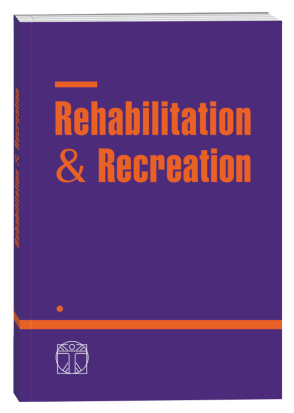REHABILITATION MANAGEMENT OF FLATFOOT IN CHILDREN OF YOUNGER SCHOOL AGE
DOI:
https://doi.org/10.32782/2522-1795.2023.15.8Keywords:
children, flat feet, rehabilitation intervention, diagnosis, physical activity.Abstract
The practical and scientific experience study shows that the rehabilitative intervention problem with flat feet on the formation of foot arches in primary school age children requires its solution in a theoretical and scientific-practical plan, taking into account the muscle tone of the lower extremities peculiarities. The aim of the study: to develop a rehabilitation intervention algorithm of flat feet in primary school age children and to check its efficiency in the conditions of pediatric hospital. The following research methods were used to achieve the goal and objectives of the specified research: scientific and methodical literature analysis; visual determination of foot mobility tests; scale FPI-6 (foot posture index); the BESS scale (balance error scoring system); physical development testing; The Oxford ankle foot questionnaire for children – OxAFQ-C; radiography; methods of mathematical statistics. For a clear understanding of the research methods’ direction in this study, they were divided according to the structural components of the ICF-PD model. The research was conducted on the basis of the Municipal non-commercial enterprise of the Sumy Regional Council «Regional Children’s Clinical Hospital». 20 children aged 6-8 took part in the study. They were divided into 2 research groups. The structure of the rehabilitation intervention algorithm for flat feet in children of primary school age corresponded to the structure of the ICF-PD model, according to which interventions were planned within each domain (structure and functions, activity and participation, environmental factors) based on the identified problems and needs of children with flat feet and contained the following algorithm of rehabilitation intervention: examination (identification of key problems), forecasting (setting SMART goals of physical therapy), planning (compilation of a physical therapy program), intervention (implementation of a physical therapy program), evaluation of effectiveness (achievement of physical therapy goals). Analyzing the results of the experimental study, it is possible to make a conclusion of the developed rehabilitation intervention algorithm effectiveness for flat feet in primary school age children in comparison with the standard program of physical therapy, which is confirmed by the set rehabilitation goals achievement in the children of the study main group.
References
Путров С. Ю., Кріт Р. М. Сучасні засоби фізичної терапії дітей дошкільного віку з функціональною недостатністю стопи на амбулаторному етапі. Науковий часопис НПУ імені М.П. Драгоманова, 2019. Вип. 3 (110). С. 481-483.
Кривов’яз К. О., Глиняна О. О. Сучасні підходи до фізичної терапії дітей молодшого шкільного віку з комбінованою плоскостопістю. Науковий часопис науково-педагогічні проблеми фізичної культури, 2019. № 15. С. 122-125.
Валецький Ю. Профілактика плоскостопості в дітей дошкільного та шкільного віку. Фізичне виховання, спорт і культура здоров’я у сучасному суспільстві, 2015. Вип. 4 (32). С.150-155.
Marzano R. Nonoperative management of adult flatfoot deformities. Clin Podiatr Med Surg, 2014. Vol. 31. №3. P. 337-347.
Banwell H., Paris M., Mackintosh S., Williams C. Paediatric flexible flat foot: How are we measuring it and are we getting it right? A systematic review. J Foot Ankle Res, 2018. Vol. 11. Р. 21.
Таможанська Г. В., Мятига О. М., Білостоцький А. І. Клінічний реабілітаційний менеджмент при порушенні діяльності опорно- рухового апарату. Матеріали Всеукраїнської науково-практичної конференції з міжнародною участю «Перспективи розвитку медичної та фізичної реабілітації», 2020. С. 110-113.
Бондюк О. А., Малярова Ю. М. Актуальність проблеми комбінованої плоскостопості у дітей молодшого шкільного віку. The VIII International Scientific and Practical Conference «Theoretical and practical methods of science development», 2023. С. 107-110.
Герцик А. Смарт-цілі в програмі фізичної терапії. Фізичне виховання, спорт і культура здоров’я у сучасному суспільстві, 2016. Вип. 2 (11). С.57-63.
Kamalakannan M., Swetha V. Efficacy of jumping rope for young age students in relation with bilateral flat foot. Biomedicine, 2020. Vol. 40. № 2. Р. 236-240.
Kristian Stoychev. Physiotherapy and orthotic treatment of pes cavus, knowledge. International Journal, 2021. Vol. 46. № 4. Р. 23-31.
Pathology and management of flexible flat foot in children. Ueki et al. J Orthop Sci, 2019. №24 (1). Р. 9-13.
Abuzayan K. Physical and physiological factors influencing dynamic. Balance, 2020. Vol. 23. № 201. Р. 1-2.
Downloads
Published
How to Cite
Issue
Section
License

This work is licensed under a Creative Commons Attribution-NonCommercial-NoDerivatives 4.0 International License.











